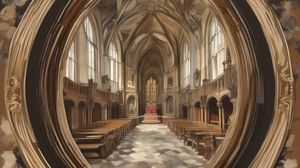
Located in the bustling heart of London, the Eros Statue at Piccadilly Circus is one of the city's most iconic landmarks. Contrary to popular belief, the statue isn't actually of Eros, the Greek god of love, but of Anteros, his lesser-known brother. Anteros represents selfless and mature love, as opposed to the more impulsive and physical nature of Eros.
The statue was designed by Sir Alfred Gilbert and unveiled in 1893 as a memorial to Lord Shaftesbury, a philanthropist known for his work on social reform in the 19th century. As you stand before it, you are not just observing a piece of art but engaging with a piece of London's historic commitment to social change.
The Eros Statue is made from aluminum, a novel material at the time of its construction, showcasing the progressive spirit of the era. It was one of the first aluminum statues in the world, highlighting both modernity and artistic vision.
The statue originally faced away from Piccadilly Circus, looking in the direction of Shaftesbury Avenue. However, it was later repositioned to face Piccadilly Circus during one of its restorations, so its configuration has a history as dynamic as its location.
The figure of Anteros is depicted with its wings spread wide and poised to launch an arrow from a bow, a pose that captures the hustle and energy of its surroundings. This sense of motion and vitality mirrors the vibrance of Piccadilly Circus itself, making it a fitting centerpiece.
Contrary to the common romantic appeal of such statues, Eros's arrow is not aimed at a lover but rather pointed downwards. This choice symbolized the philanthropic aim of Lord Shaftesbury's life work, grounding the sculpture in a message of earnest commitment to others.
Although the statue has stood for well over a century, it remains a favorite meeting spot and photo opportunity for visitors and locals alike. Its presence in such a lively part of London cements its status as a beacon of both historical and contemporary significance.

Making the Most of Your Visit:
Take a moment to appreciate the statue's material. It's one of the first in the world to be made out of aluminum, which was groundbreaking at the time of its unveiling in 1893.
While you're there, look closely at the direction in which the statue faces. Originally, it was oriented towards Shaftesbury Avenue but now faces Piccadilly Circus. This shift actually reflects some of London's changing urban dynamics over the years.
Notice the little details, like how Anteros seems to float above the shaft. This design choice by Sir Alfred Gilbert wasn't just for aesthetics; it represents the ideal of selfless love buoyed above worldly concerns, quite a thoughtful reflection next time you're snapping a picture.
If you're visiting at night, take advantage of the vibrant lights of Piccadilly Circus surrounding the statue. The modern illumination complements the historical aspect of the statue's story and makes for a dazzling photo setting.
It's common to hear the statue called "Eros," but make sure to drop some knowledge on your friends that it's actually Anteros, the god of selfless love. It'll impress them and deepen your own appreciation of its symbolic importance!

Visiting Times & Costs:
The Eros Statue, located at Piccadilly Circus, is accessible to the public 24 hours a day, seven days a week. There are no entrance fees or charges associated with visiting the statue, as it is situated in a public space.
Accessibility in the area is generally good, given that Piccadilly Circus is a busy district with pedestrianized zones. However, due to the high volume of foot traffic, it may be crowded at times, which could pose challenges for those with mobility issues. The vicinity around the statue is generally flat and paved, facilitating wheelchair access, although the constant activity in the area should be considered when planning a visit.

Address & Map:

Nearby:























